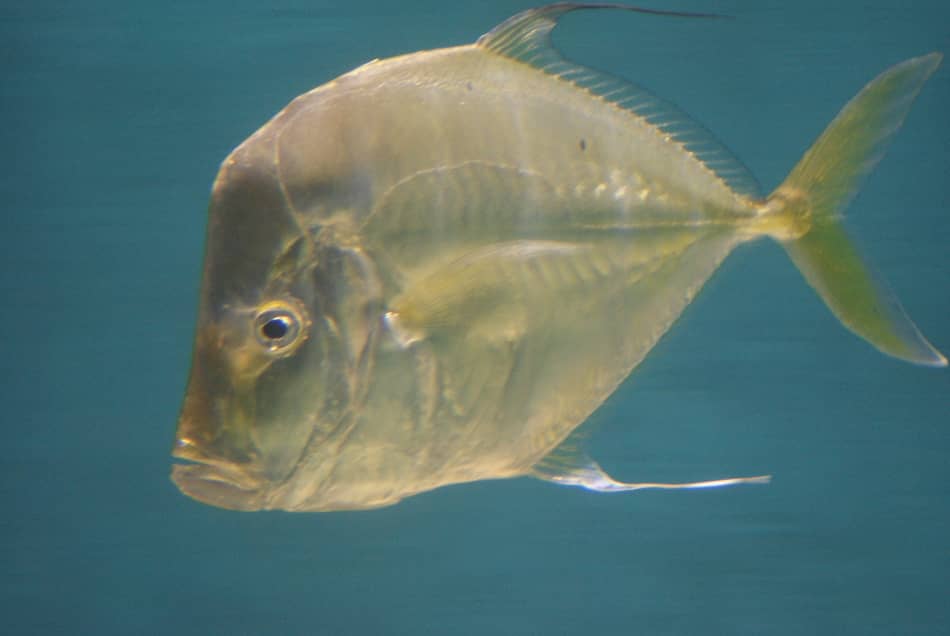
Catching Lookdown is a unique fishing adventure that many inshore anglers have added to their fishing bucket list. Let’s take a look at how to catch Lookdown, where to find them, and tips and tricks to make your experience more successful.
How To Catch Lookdwon
Lookdown are caught fishing live bait, artificial lures, or on fly. Lookdown are found nearshore on marine structures, including dock pilings, rocks, boats, and navigational markers. Lookdown are caught using light tackle in shallow waters ranging from 5’ to 20’ in-depth and prefer hard sandy bottoms.
Regardless of the fishing technique employed, one factor remains constant when targeting Lookdown, that is, the presence of shallow water structures.
When it comes to fishing for Lookdown, it is essential that whatever bait/lure you are using is small in overall diameter to accommodate the small mouths of the fish. I have always had the best luck fishing small live shrimp on light tackle. If the area you are fishing is in mild to moderate current, it is best to add a sinker to keep your bait stationary long enough for the Lookdown to strike your bait.
Likewise, If you are looking to catch Lookdown using artificial lures, it is essential that your lure be small in overall diameter, measuring less than 1 ½”. Lookdown can be caught on a range of lures, including small twitch baits, spoons, and artificial shrimp, but nothing has ever compared to the success we have had fishing small white jigs. Lookdown prefer the erratic up and down presentation that is possible when retrieving a jig by bouncing the tip of your rod. It seems that Lookdown can not resist the jig as it travels up and down the water column.
Some anglers enjoy the challenge of fishing for Lookdown using a fly rod. If you elect to try your hand at catching Lookdown on a fly setup, you’ll need to be pretty accurate at delivering a fly near structures without getting it caught up in the structure. It is best to use a small white/silver fly measuring 1” to 1 ½” in length on a sinking fly line. Having a sinking fly line will allow your fly to sink into different depths within the water column giving the fly the bait presentation Lookdown go crazy over.
Here Are My Top 7 Tips for Catching Lookdown
- Find the moving water: Lookdown feed most actively when there is a strong current moving through nearshore structures. Though Lookdown can be caught on any tide, they are most active during the beginning of a falling high tide.
- Fish the lights at night: Lookdown can be caught throughout the day, however, they are most active feeding at night, especially under dock lights. Anglers often end up catching Lookdown when they are trying to catch Snook on dock lights.
- Choose the right lure color: When it comes to fishing for Lookdown it is important to choose the right lure color depending on the clarity of the water. If the water is extremely dark, it is best to fish with a light brown or darkish gray lure, whereas if you are fishing clear water, a white or opaque silver is best. Lookdown have excellent eyesight, so anything that seems unnatural for their environment will not be eaten.
- Try the vertical jig: If the Lookdown you are targeting are directly underneath the dock or boat you are fishing, you are in luck. Lookdown can not resist an angler popping their lure up down using a vertical jigging technique. Often you will see the lookdown dart after your lure while it’s sinking and then hitting it the moment you attempt to jig the lure back up to the surface.
- Be stealthy: Lookdown are extremely skittish fish, often completely disappearing the moment another fish is hooked in the school, so make sure that you remain quiet.
- Find clear water: Though juvenile Lookdown can be caught in murky brackish water, mature Lookdown are prevalent in clear waters with high salinity levels. Because of this, Lookdown are prominently found inhabiting structures closest to inlets and passes where heavy tidal flow brings nutrient-dense water with high levels of salinity.
- Fish light tackle: Lookdown have excellent eyesight, so fishing with light tackle is essential to success. I recommend fishing 15lb fluorocarbon.
Here Are My Top 3 Artifical Lures for Lookdown
- Felmlee Buckytail Jig
- No-Alibi Peal Alien Jigs
- Storm 360′ GT Searchbait
When Can You Catch Lookdown?
Lookdown can be caught throughout the year but are most prevalent from May to September during heavy tidal movement.
Where Can You Catch Lookdown?
Lookdown are caught in tropical and subtropical waters congregating heaviest around hard sandy bottoms in 10’ to 20’ of water.
Top Fishing Areas for Catching Lookdown
- Dock pilings
- Moored boats
- Rock Piles
- Jetties
- Bridges
Natural Lookdown Diet:
- Shrimp
- Worms
- Crustaceans
- Baitfish (varying species)
Best Fishing Tackle for Catching Lookdown
When it comes to targeting Lookdown, having the correct fishing tackle will dramatically increase your chances of catching more fish.
Lookdown Rod & Reel Setup
When targeting Lookdown, it is best to keep your fishing tackle light to increase the overall sport of fishing and increase the number of bites. I recommend fishing with a medium to a medium-light fishing rod and a 2000 to 3000 sized reel.
Best Pound Test Line for Lookdown
When targeting Lookdown, using a 20lb to 30lb braid is ideal.
Best Fishing Leader for Lookdown
Lookdown have excellent eyesight, so using a 15lb or smaller fluorocarbon leader is optimal.
Best Hook Size for Lookdown
If you are targeting Lookdown with live bait, a 1/0 circle hook is ideal.
What Are Lookdown?
Selene Vomer, frequently called Lookdown, are small saltwater fish found in tropical, subtropical, and temperate waters. Lookdown are characterized by their slender bodies, extreme concaved head, silvery sides with high eyes, and low mouth, giving the fish the appearance that it is “looking down,” hence its name. Lookdown are known by other names, including Hairfinned Dory, Jorobado, Dollarfish, and Moonfish.
Are Lookdown Good To Eat?
Lookdown are an excellent fish to eat. Lookdown flesh is flaky and white with a mild buttery flavor profile. Because of their small, slender bodies, Lookdown are rarely harvested by anglers, however, those who do decide to keep them often cook them whole to not waste any part of the fish.
Are Lookdown And Jack In The Same Family?
Lookdown and Jack are related, both being in the Carangidae family.
Do Lookdown Have Scales?
Lookdown do have small scales that start from their gill plates and end at the base of their tail. Lookdown scales are extremely small, giving them a slimy, smooth texture when handled.
Do Lookdown Have Teeth?
Lookdown have palatine tooth patches on both the top and bottom of their jaws, and these teeth feel more like rough sandpaper than what many would consider teeth. Their palatine teeth, with assistance from their swim bladder, give the Lookdown the ability to grunt.
